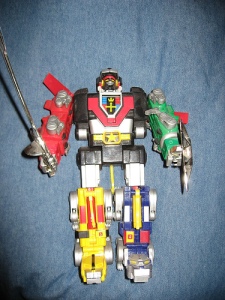Remember the 1980s cartoon Voltron?
I do.
Voltron was a cartoon about five robot lions that combined to form a giant robot humanoid warrior named Voltron. The lions were not self-animating but were each piloted by a human being. I did not really care about the human beings. I don’t profess to know the history of Voltron, the story of Voltron, or even the names of the characters. In this pillar of geek culture I am, at best, a dabbler. Doctoral dissertations have likely been written on this subject and I am humbly aware that there is nothing that I can say that will contribute anything new to the analysis of 1970s anime that evolved into this show and its progeny.
All I can contribute is what Voltron meant to me. And what it meant was five robot lions forming a giant humanoid robot warrior with lion-heads for hands and feet, all to very awesome music.
My entire reason for watching Voltron was to watch them form Voltron. I watched He-Man for the moment when [spoiler alert] Adam turned into He-Man, and I watched Voltron for the moment when the five robot lions formed Voltron. These lions would be fighting some evil force in the universe – a giant alien monster, a giant alien robot, Grendel – and things would not be going well, and all of a sudden one of the lion pilots would suggest forming Voltron.
I never understood why they did not form Voltron the minute they saw the evil-doers coming over the Throgs Neck Bridge. But I will try to describe the experience. The pilot of the leader lion would press some controls, the key to his lion would shift around in the ignition and glow, there would be a collage of all five pilots of the robot lions saying “Voltron Force,” and then the music would start.
Oh that music. All great cartoon moments involve music. Voltron formed to electronic trumpets, guitars, and drums, and my image of the battle between good and evil formed to Voltron forming. The pilots of the robot lions would talk the audience through the formation.
[Trumpets, trumpets]
“Form feet and legs!”
[Guitars, drums]
“Form arms and torso!”
[Trumpets, guitars, drums]
“And I’ll form the head!”
I remember that Voltron was formed in exactly this manner in every single episode. I don’t recall any “express” formation of Voltron where certain steps were truncated. I don’t recall ever seeing Voltron show up to the party already formed, smoking a cigarette and sipping a giant robot martini.
The moment Voltron formed was the most exciting moment of my life for that day. There was nothing more satisfying to my pre-adolescent mind than the combination of electronic fight music and robot lions interlocking to form a giant humanoid robot warrior. But as happened with so many shows for me, the plot of Voltron became too complicated to follow. Something about a love story and zoning regulations. Perhaps I sustained brain damage from eating bowls of Count Chocula. Whatever the reason, I did not care about the story. I just wanted them to play the music and form Voltron, again and again. But alas, my family did not have a VCR at the time, and thus I had no means of recording the show. The forming of Voltron would be just another childhood gem that would live only in my fading memory.
And then along came this thing called YouTube, where an adult can be a kid when he’s supposed to be working. It did not matter that there was a pile of dirty dishes in the sink and a pile of dirty snow in the driveway. I had returned home, at last, rocking back and forth in my chair, heart racing along with the music, watching them form Voltron again and again, and remembering the days when, in between commercials, good battled evil.




